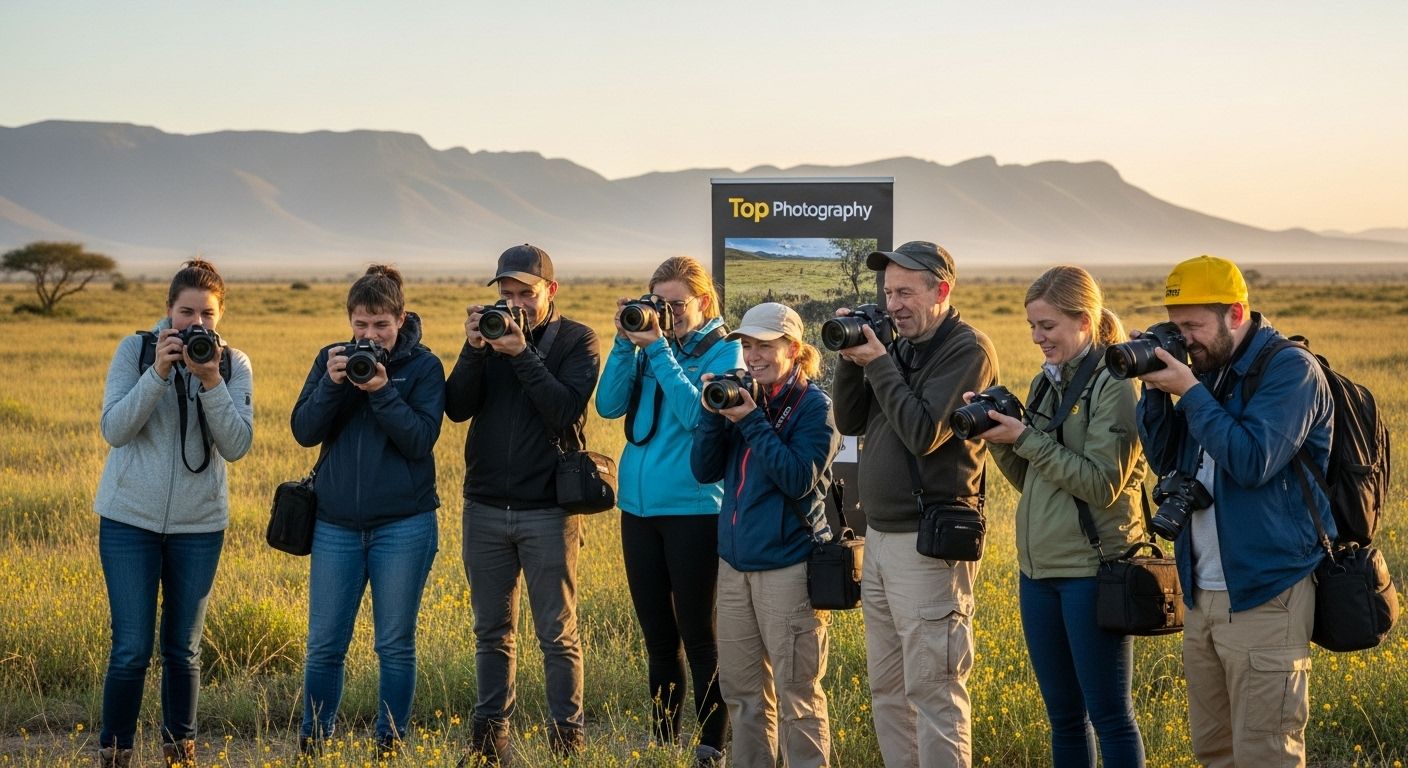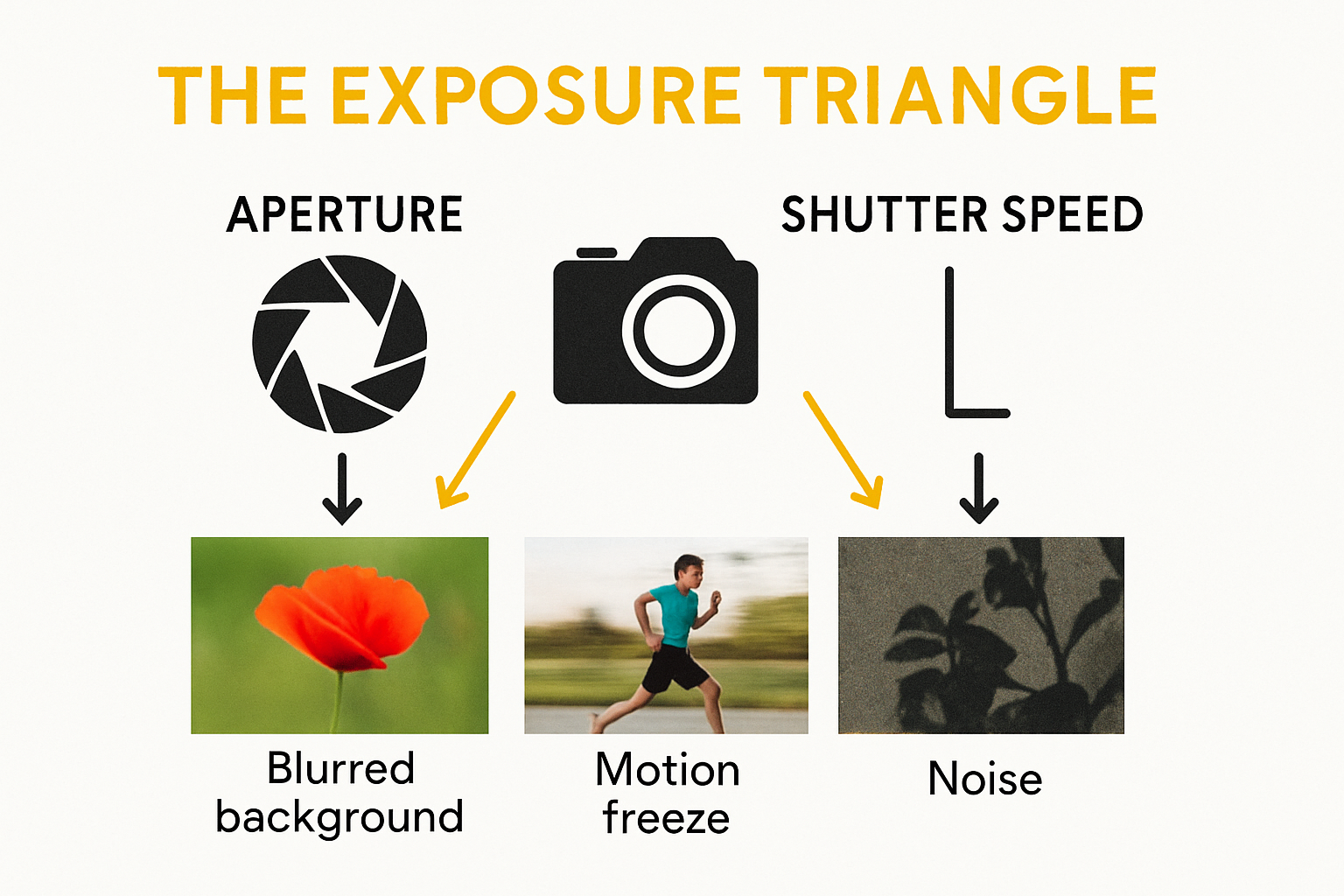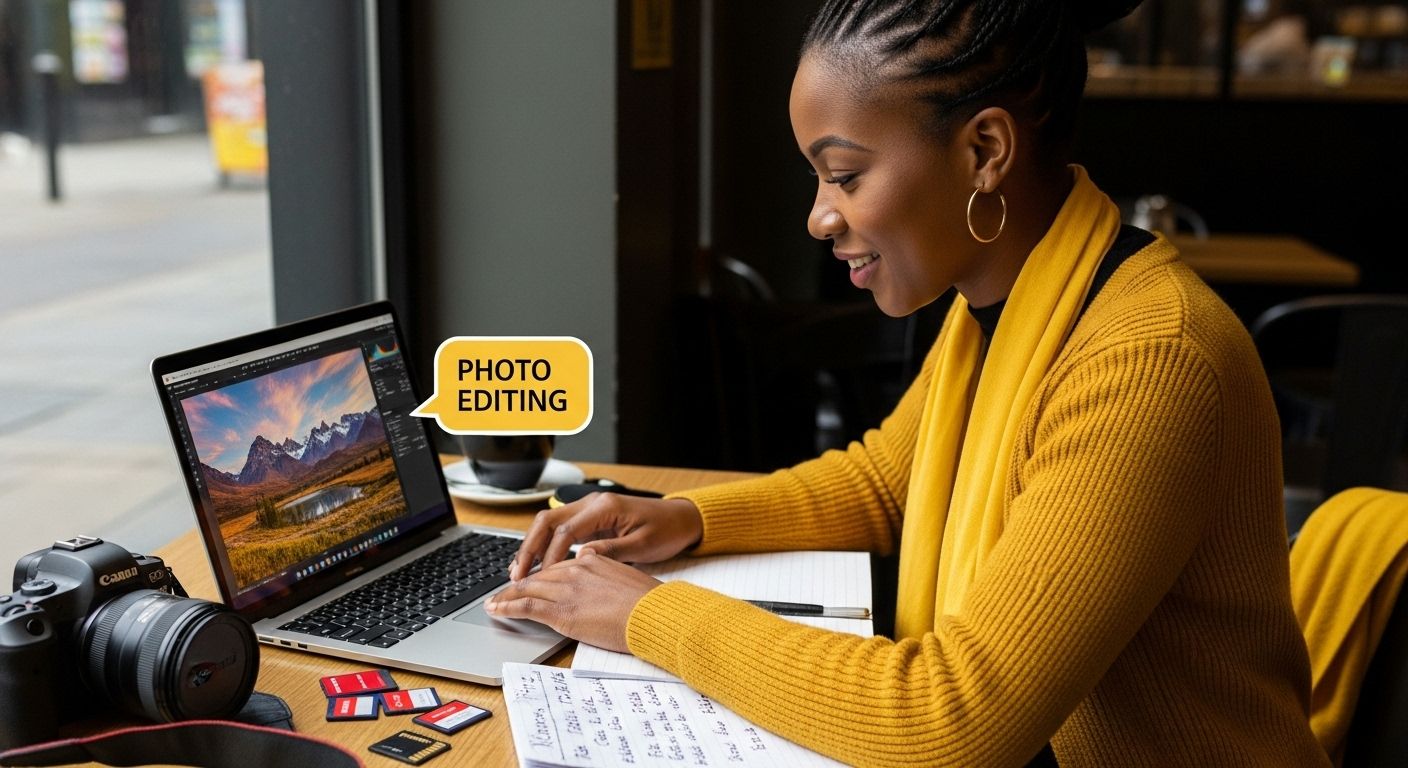
Photography in South Africa opens up a world of wild safaris, dramatic coastlines, and bustling cities all waiting for your lens. Yet shockingly, most beginners miss out on these breathtaking moments because they struggle with basics—stats show over 60 percent of new photographers never move past auto mode on their cameras. What if the secret to powerful, eye-catching images lies not in expensive gear, but in a few simple tricks anyone can master with the camera they already have?
Table of Contents
- Choosing The Right Camera And Gear
- Essential Photography Settings Explained
- Composing Stunning Shots With Ease
- Editing And Sharing Your Photos Online
Quick Summary
| Takeaway | Explanation |
|---|---|
| Select the right camera type | Beginners should start with DSLRs for versatility or mirrorless cameras for compactness and quality. |
| Master your exposure triangle | Understand how aperture, shutter speed, and ISO interact to control image quality and mood. |
| Apply compositional techniques | Use the rule of thirds, leading lines, and perspective to create engaging and impactful photographs. |
| Edit photos for better storytelling | Master basic editing techniques to enhance images and make them more visually appealing after capturing. |
| Share wisely online | Choose platforms that fit your goals and engage with communities for feedback and inspiration while safeguarding your work. |
Choosing the Right Camera and Gear
Starting your photography journey in South Africa requires making smart gear choices that balance quality, affordability, and versatility. Whether you are capturing the vibrant landscapes of the Drakensberg or documenting urban scenes in Johannesburg, selecting the right camera and accessories can significantly impact your photography experience.
Understanding Camera Types for Beginners
For new photographers, the camera market offers multiple entry points. Digital Single Lens Reflex (DSLR) cameras remain popular among beginners due to their versatility and robust build. According to Digital Camera World, entry-level DSLRs like the Canon EOS Rebel series provide excellent image quality and interchangeable lens capabilities at reasonable prices.
Mirrorless cameras present another compelling option for photography tips for beginners. These lightweight cameras offer comparable image quality to DSLRs while being more compact. Photography Life reports that mirrorless technology has advanced rapidly, making them an increasingly attractive choice for newcomers seeking professional-grade performance.
Essential Accessories for South African Photography
Below is a table summarising key accessories beginners should consider when photographing in South Africa, along with their purpose and tips for selection.
| Accessory | Purpose | Beginner Tip/Consideration |
|---|---|---|
| Tripod | Stabilises camera for sharp images | Choose one suited for varied, rugged terrain |
| Zoom Lens (18-55mm) | Versatile for various scenes | Ideal starter for flexibility |
| Wide-Angle Lens | Captures expansive landscapes | Great for scenery and sweeping views |
| Telephoto Lens | Suitable for wildlife, sports | Look for lightweight options if hiking |
| Camera Bag (Weatherproof) | Protects gear from dust, moisture, impact | Pick with padded compartments and water resistance |
| Memory Cards (High-Capacity) | Store more photos, faster processing | Carry multiples for remote shooting |
| Extra Batteries | Ensures continued shooting in remote areas | Pack at least one spare, especially for travel |
Lens selection matters immensely. For beginners, a versatile zoom lens covering 18-55mm provides flexibility for multiple shooting scenarios. Wide-angle lenses work perfectly for capturing expansive landscapes, while telephoto lenses suit wildlife and sports photography.
Protective gear is equally important given South Africa’s diverse and sometimes challenging environments. A weatherproof camera bag that shields equipment from dust, moisture, and potential impact can be a wise investment. Look for bags with padded compartments and water-resistant materials designed for outdoor adventures.
Memory cards and extra batteries should never be overlooked. South African photographers often find themselves in remote locations where charging or purchasing replacements might be challenging. Always carry multiple high-capacity, fast-read memory cards and at least one spare battery.
While professional-grade equipment can be tempting, new photographers should focus on understanding fundamental techniques before making significant financial investments. Start with a reliable, user-friendly camera that allows manual controls and grows with your skills. Many manufacturers offer starter kits that include essential accessories, providing excellent value for emerging photographers.
Remember that the best camera is the one you will consistently use. Choose equipment that feels comfortable, matches your budget, and inspires you to continue learning and exploring the fascinating world of photography.
Essential Photography Settings Explained
Understanding camera settings is crucial for transforming basic snapshots into compelling photographs. Photography tips for beginners often emphasize mastering three fundamental settings: aperture, shutter speed, and ISO. These elements form the exposure triangle, which determines the overall quality and mood of your images.
Mastering the Exposure Triangle

The exposure triangle represents the core technical foundation of photography. According to Cambridge in Colour, these three interconnected settings control how light enters and is processed by your camera.
Aperture controls the amount of light entering through the lens and affects depth of field. Lower f-numbers like f/1.8 create a shallow depth of field with blurred backgrounds, perfect for portrait photography. Higher f-numbers like f/16 keep more of the scene in sharp focus, ideal for landscape shots.
Shutter Speed determines how long the camera’s sensor is exposed to light. Faster speeds like 1/1000 second freeze motion, while slower speeds like 1/30 second can create motion blur. Digital Photography School recommends beginners practice with different shutter speeds to understand their creative potential.
ISO measures the camera sensor’s sensitivity to light. Lower ISO values like 100 produce cleaner images with less digital noise, while higher values like 1600 allow photography in low-light conditions but introduce more grain.
Below is a table summarising the components of the exposure triangle and their effects, to help beginners grasp their roles in photography.
| Setting | What It Controls | Example Value | Typical Use | Effect on Image |
|---|---|---|---|---|
| Aperture | Amount of light & depth of field | f/1.8 (low), f/16 (high) | f/1.8 for portraits, f/16 for landscapes | Blurred background or sharp throughout |
| Shutter Speed | Duration of light exposure | 1/1000 sec (fast), 1/30 sec (slow) | Fast for action, slow for motion blur | Freezes or blurs motion |
| ISO | Sensor’s sensitivity to light | 100 (low), 1600 (high) | Low for daylight, high for dim scenes | Cleaner or grainier image |
Understanding White Balance and Focus Modes
White balance ensures colors appear natural under different lighting conditions. Most cameras offer preset modes like daylight, cloudy, tungsten, and fluorescent. These settings compensate for color temperature variations, preventing unwanted color casts in your images.
Focus modes are equally critical. Autofocus (AF) works well for most situations, with multiple point selection options. Single-point AF allows precise focus on specific subjects, while continuous AF tracks moving objects. Manual focus provides ultimate control, especially in challenging lighting or when photographing intricate details.
Beginner photographers should experiment with these settings in various environments. Practice switching between modes, understanding how each adjustment impacts the final image. Start in semi-automatic modes like Aperture Priority or Shutter Priority, which allow controlled experimentation while providing some automatic assistance.
Remember that technical mastery comes with consistent practice. Don’t be intimidated by complex settings. Each photograph is an opportunity to learn and refine your skills. Start simple, review your images critically, and gradually expand your technical understanding.
Most modern cameras offer extensive automated and semi-automated modes that help beginners transition smoothly from automatic to manual control. These modes provide a supportive learning environment, allowing you to understand how different settings interact without feeling overwhelmed.
Photography is both a technical skill and an art form. While understanding camera settings is crucial, developing your creative vision is equally important. Experiment, make mistakes, and enjoy the learning process.
Composing Stunning Shots with Ease
Creating visually compelling photographs goes beyond technical camera skills. Composition is the art of arranging elements within your frame to create impactful and engaging images. For photography tips for beginners, understanding fundamental compositional techniques can transform ordinary scenes into extraordinary visual stories.
The Rule of Thirds and Beyond
The rule of thirds is a foundational compositional technique that helps create balanced and interesting images. According to REI’s photography guide, this technique involves mentally dividing your frame into a 3x3 grid and placing key elements along these lines or at their intersections.
Instead of centering your subject, positioning it slightly off-center creates visual tension and draws the viewer’s eye through the image. For landscape photography, place the horizon line on the upper or lower third of the frame rather than splitting the image in half. In portrait photography, align the subject’s eyes with the grid’s intersection points to create a more dynamic composition.
Creating Depth and Visual Interest
MasterClass photography experts recommend incorporating foreground, midground, and background elements to add depth to your photographs. This technique creates layers that guide the viewer’s eye through the image and provide a sense of dimension.
Leading lines are another powerful compositional tool. Natural or architectural lines can draw the viewer’s gaze toward the main subject. Consider using roads, fences, shorelines, or architectural elements to create visual pathways within your image.
Balancing Elements and Experimenting with Perspective
Adorama’s composition techniques highlight the importance of both symmetrical and asymmetrical balance. Symmetrical compositions create a sense of harmony and order, while asymmetrical compositions introduce dynamic tension and visual interest.
Experimenting with different perspectives can dramatically transform an ordinary scene. Get low to the ground, climb to a higher vantage point, or move closer to your subject. Each perspective offers a unique way of seeing and interpreting the world around you.
Pay attention to negative space the areas around and between your subjects. Thoughtful use of negative space can emphasize your main subject and create a more powerful visual statement. Sometimes, what you choose to leave out of the frame is as important as what you include.
Color and contrast play crucial roles in composition. Look for complementary colors or interesting color relationships that can add visual excitement to your images. High-contrast scenes can create dramatic and eye-catching photographs.
Remember that composition is a skill that develops with practice. Don’t be afraid to break traditional rules once you understand them. Photography is an art form, and your unique perspective is what will make your images truly special.
Start by being intentional about your framing. Move around your subject, experiment with different angles, and take multiple shots. Review your images critically, understanding what works and what doesn’t. With time and practice, compositional techniques will become second nature, allowing your creative vision to shine through.
Editing and Sharing Your Photos Online
In the digital age, photography extends beyond capturing images to include editing and online sharing. Understanding post-processing techniques and digital platforms can significantly enhance your photography journey and help you connect with a broader audience of fellow photography enthusiasts.
Essential Photo Editing Techniques
National Geographic recommends mastering basic editing skills to transform good photographs into exceptional visual stories. Modern editing software offers a range of tools that can help beginners refine their images without requiring advanced technical knowledge.
Basic editing techniques include adjusting exposure, which helps balance light and dark areas in your photograph. Exposure correction can rescue images taken in challenging lighting conditions, bringing out details that might have been initially hidden. Contrast adjustment helps create more vibrant and impactful images by enhancing the difference between light and dark elements.
Color correction is another crucial editing skill. White balance adjustments ensure colors appear natural and true to the original scene. Saturation and vibrance tools allow photographers to make colors more vivid or muted, depending on the desired aesthetic.
Choosing the Right Editing Software
The following table compares some popular editing software options mentioned in the article, highlighting features relevant to beginner photographers.
| Software | Type | Key Features | Suitable For |
|---|---|---|---|
| Adobe Lightroom | Desktop/App | Professional editing, presets | Intermediate/Pro |
| GIMP | Desktop | Free, open-source, robust tools | Beginners/Budget |
| Snapseed | Mobile App | Easy controls, filters, free | Beginners/Mobile |
| VSCO | Mobile App | Filters, quick edits, sharing | Beginners/Mobile |
When selecting editing software, consider user interface, available tools, and compatibility with your device. Many platforms offer free trials, allowing you to explore features before committing to a specific tool. Look for software with intuitive controls and comprehensive tutorials to support your learning process.
Strategic Online Photo Sharing
Louisiana State University research highlights the importance of thoughtful online photo sharing. Choose platforms that align with your photography goals. Instagram remains popular for visual storytelling, while Flickr offers more advanced community features for serious photographers.
Consider your privacy and copyright when sharing images online. Use watermarks to protect your work, and understand the terms of service for each platform. Some sites retain rights to images uploaded, so read guidelines carefully.
Engaging with online photography communities can provide valuable feedback and inspiration. Join photography groups, participate in constructive discussions, and be open to learning from more experienced photographers. Many platforms offer challenges and themed competitions that can help improve your skills.
Remember that online sharing is about connection and growth. Not every image needs to be perfect. Share photographs that tell a story, evoke emotion, or capture a unique moment. Your perspective and personal style are what make your photography distinctive.
Be consistent in your sharing and develop a recognizable aesthetic. This doesn’t mean using the same filter on every image, but creating a cohesive visual narrative that reflects your unique vision. Experiment with different styles, learn from feedback, and enjoy the process of sharing your photographic journey with the world.

Frequently Asked Questions
What type of camera is best for beginners in South Africa?
For beginners in South Africa, Digital Single Lens Reflex (DSLR) cameras are popular due to their versatility and robust build. Alternatively, mirrorless cameras are a compact option offering similar quality and features, making them ideal for newcomers.
How do I make the most of the exposure triangle in photography?
Mastering the exposure triangle involves balancing aperture, shutter speed, and ISO. Use a low f-number for portrait photography to achieve a blurred background, choose a fast shutter speed to freeze motion, and set a low ISO for well-lit conditions to maintain image quality without noise.
What accessories should I consider for photography in South Africa?
Essential accessories include a sturdy tripod, versatile zoom lens (18-55mm), weatherproof camera bag, high-capacity memory cards, and extra batteries for remote shooting. These tools will enhance your photography experience and ensure you’re prepared for various conditions.
How can I improve my photo composition as a beginner?
Begin by applying the rule of thirds to create balanced images. Incorporate foreground and background elements for depth, utilize leading lines to draw attention to your subject, and experiment with different angles and perspectives. The key to improvement is practice and reviewing your shots critically.
Elevate Your Photography Journey with the Right Tech
Starting out in photography often feels overwhelming. You spend time learning about exposure, the rule of thirds, and perfecting each shot. Yet without the right equipment or accessories, you might miss that one-in-a-million wildlife moment or struggle to capture South Africa’s iconic landscapes as vividly as you see them. Many beginners hesitate to invest in gear because of high prices or uncertainty about what actually works for their needs.
PMC Jewellery has transformed into South Africa’s leading all-in-one technology marketplace, bridging the gap between inspiration and action for photographers just like you. From versatile camera accessories to memory cards, protective gear, lighting tools, and mobile tech upgrades, you will find top-rated essentials all under one roof. Head over to our best-selling collection, browse customer favourites, and take advantage of exclusive savings. Discover the Smart Choice Marketplace today and start equipping yourself to capture South Africa’s beauty your way. Why settle for ordinary when you can make every shot count with the latest tech, delivered nationwide? Shop now at pmcjewellery.co.za and take the next step towards becoming the photographer you want to be.
Recommended
- For Samsung Galaxy Watch 5 44mm 20mm Two-color Stripe Silicone Watch B – PMC Jewellery
- For Samsung Galaxy Watch 46mm / Gear S3 Universal Sports Two-tone Sili – PMC Jewellery
- For Samsung Galaxy Watch 4 40mm 20mm Silicone Pasted Leather Watch Ban – PMC Jewellery
- 20mm Top Layer Cowhide Sewing Watch Band For Apple Watch Ultra 49mm&Wa – PMC Jewellery
